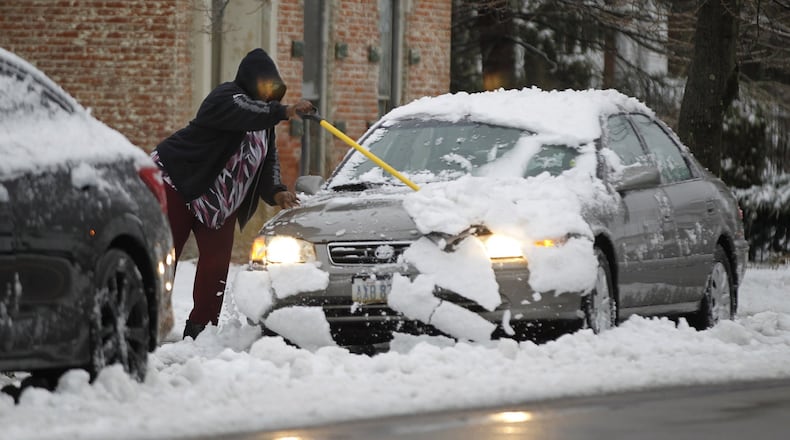JANUARY
Southwest Ohio started abnormally warm, but the bottom quickly dropped out. By mid-month, one of the biggest snowfalls in years would bury many under several inches of snow. Most areas ranged between 5 to 10 inches with Dayton breaking the daily snowfall record for Jan. 12 with 6.1 inches. Another snowstorm would sweep across the area the following weekend, bringing another dose of winter. The month would round out with more than 14 inches of snow for both Cincinnati and Dayton.
>>RELATED: With distribution center destroyed, Frito-Lay searches for new site
FEBRUARY
While typically one of the coldest months of the year, this past February would lean warmer than normal with above-average rainfall. Dayton would rank 3rd for wettest February with 6.15 inches and 5th wettest for Cincinnati with 7.23 inches of precipitation.
Between rounds of heavy rain, severe weather also showed up early in the month. On Feb. 7, an EF-0 twister touched down in Pitchen, Ohio, and remained on the ground for roughly 7.5 miles.
MARCH
March may have been one of the quietest months of the year so far, but it did come with some dramatic temperature swings. At times the temperatures would fall to 20 degrees below normal and then to 20 degrees above normal. The coldest day of the month occurred on March 5 with lows in the single digits and highs in the lower 20s for both Dayton and Cincinnati. The high temperatures on that day would break the record coldest high for both cities. Less than a week later, temperatures soared into the lower to middle 70s.
March would also prove to be a very wet month. In fact, Cincinnati would finish with a total of 5.82 inches of precipitation, which is 1.86 inches above normal.
APRIL
The severe weather doors opened wide during the month of April. April 12 would be the first day the area would experience tornadoes since February, with two tornadoes confirmed in Clark County. Two days later, another tornado would touch down within the same county. On April 25, the fourth tornado of the month would cause minor damage in Darke County. These three events would also contribute to an above-normal amount of precipitation for the month.
MAY
Then came the month of May. Of course at the forefront of our mind is the Memorial Day tornadoes, but there was much more to the month than that.
During the early-morning hours of March 17, storms produced large hail before transitioning to a flash flooding threat. More than 5 inches of rain fell in parts of the northern Miami Valley, causing some homes to be stranded in high water. By the end of the month, the area would once again finish above normal for precipitation. Dayton, in particular, would receive more than 6 inches of rainfall, nearly an inch and half above average.
On March 19, three EF-1 tornadoes would occur, one in Huber Heights, one in West Alexandria and another in Eaton. The damage from these storms caught many off-guard.
At the end of the month, we all know what happened. Twenty-one tornadoes would be confirmed across Ohio on Memorial Day with 15 of those in the Miami Valley. The strongest recorded that day was an EF-4 twister with winds up to 170 mph that stayed on the ground for nearly 20 miles.
Looking Ahead
As we move into the month of June, the Climate Prediction Center calls for a near-normal month for temperature and precipitation. On average, the normal high for the month falls around the lower 80s for both Dayton and Cincinnati with normal precipitation amounts around 4 inches.
Here’s hoping the rainfall and the threat for severe weather will be lower than we’ve seen recently.
About the Author

